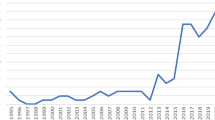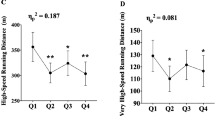Abstract
Purpose
The current study examined the reliability of a novel Gaelic football match simulation protocol (GFSP) that simulates the match-specific activity demands of elite Gaelic football match-play.
Methods
After familiarisation, 16 male Gaelic footballers performed the GFSP on two occasions, 7–10 days apart to determine the reliability of a range of team sport performance indicators.
Results
The total distance (TD), high-speed running distance (HSRD) and sprint distance were 8479 ± 594 m, 2349 ± 308 m and 651 ± 319 m, respectively. In addition, decrements in TD (− 2.4%), HSRD (− 11.2%) and sprint distance (− 32.6%) from first to second half were observed. There was no significant difference between repeated trials of the GFSP for all running performance and physiological measurements. The GFSP demonstrates good test–retest reliability for the majority of performance and physiological responses. Between trial coefficient of variations (CV) and intraclass correlation coefficients (ICC) were: TD 1.9%, 0.93; HSRD 3.0%, 0.93; sprint distance 17.6%, 0.86; peak speed 4.5%, 0.60; mean heart rate (HR) 1.8%; 0.94; peak HR 2.2%, 0.89.
Conclusion
The current investigation shows that the GFSP replicates the average movement demands of elite Gaelic football match play. The current simulation is reliable and may be seen by practitioners as a viable monitoring tool within the Gaelic football research and training process to monitor the effectiveness of various training and nutritional interventions on Gaelic football-related performance.


Similar content being viewed by others
References
Malone S, Solan B, Hughes B, Collins K (2017) Duration specific running performance in elite Gaelic football. J Strength Cond Res. https://doi.org/10.1519/JSC.0000000000001972
Malone S, Solan B, Collins K (2017) The running performance profile of elite Gaelic football match-play. J Strength Cond Res 31:30–36. https://doi.org/10.1519/JSC.0000000000001477
Malone S, Solan B, Collins K, Doran D (2016) The metabolic power and energetic demands of elite Gaelic football match play. J Sports Med Phys Fitness. https://doi.org/10.23736/S0022-4707.16.06233-2
Malone S, Solan B, Collins KD, Doran DA (2016) Positional match running performance in elite Gaelic football. J Strength Cond Res 30:2292–2298. https://doi.org/10.1519/JSC.0000000000001309
Keane S, Reilly T, Hughes M (1993) Analysis of work-rates in Gaelic football. Aust J Sci Med Sport 25:100–100
Gamble D, Spencer M, Mccarren A, Moyna N (2019) Activity profile, PlayerLoadTM and heart rate response of Gaelic football players A pilot study. Journal of Human Sport and Exercise. Doi: https://doi.org/10.14198/jhse.2019.144.01
Gregson W, Drust B, Atkinson G, Salvo VD (2010) Match-to-match variability of high-speed activities in premier league soccer. Int J Sports Med 31:237–242. https://doi.org/10.1055/s-0030-1247546
Mangan S, Ryan M, Devenney S et al (2017) The relationship between technical performance indicators and running performance in elite Gaelic football. Int J Perform Anal Sport. https://doi.org/10.1080/24748668.2017.1387409
Mangan S, Ryan M, Shovlin A et al (2017) Seasonal changes in Gaelic football match-play running performance. J Strength Cond Res. https://doi.org/10.1519/JSC.0000000000002269
Mangan S, Malone S, Ryan M et al (2018) Influence of team rating on running performance in elite Gaelic football. J Strength Cond Res 32:2584–2591. https://doi.org/10.1519/JSC.0000000000002316
Carling C, Bradley P, McCall A, Dupont G (2016) Match-to-match variability in high-speed running activity in a professional soccer team. J Sports Sci 34:2215–2223. https://doi.org/10.1080/02640414.2016.1176228
Kempton T, Sirotic AC, Coutts AJ (2014) Between match variation in professional rugby league competition. J Sci Med Sport 17:404–407. https://doi.org/10.1016/j.jsams.2013.05.006
Nicholas CW, Nuttall FE, Williams C (2000) The Loughborough intermittent shuttle test: a field test that simulates the activity pattern of soccer. J Sports Sci 18:97–104. https://doi.org/10.1080/026404100365162
Atkinson G, Nevill AM (1998) Statistical methods for assessing measurement error (reliability) in variables relevant to sports medicine. Sports Med 26:217–238. https://doi.org/10.2165/00007256-199826040-00002
Roberts SP, Stokes KA, Weston L, Trewartha G (2010) The Bath University rugby shuttle test (BURST): a pilot study. Int J Sports Physiol Perform 5:64–74. https://doi.org/10.1123/ijspp.5.1.64
Sykes D, Nicholas C, Lamb K, Twist C (2013) An evaluation of the external validity and reliability of a rugby league match simulation protocol. J Sports Sci 31(48):57. https://doi.org/10.1080/02640414.2012.720702
Scanlan AT, Dascombe BJ, Reaburn PRJ (2014) Development of the basketball exercise simulation test: a match-specific basketball fitness test. J Hum Sport Exerc 9:700–712. https://doi.org/10.14198/jhse.2014.93.03
Williams JD, Abt G, Kilding AE (2010) Ball-sport endurance and sprint test (BEAST90): validity and reliability of a 90-minute soccer performance test. J Strength Cond Res 24:3209–3218. https://doi.org/10.1519/JSC.0b013e3181bac356
Stone KJ, Oliver JL, Hughes MG et al (2011) Development of a soccer simulation protocol to include repeated sprints and agility. Int J Sports Physiol Perform 6:427–431. https://doi.org/10.1123/ijspp.6.3.427
Bishop D, Spencer M (2004) Determinants of repeated-sprint ability in well-trained team-sport athletes and endurance-trained athletes. J Sports Med Phys Fitness 44:1–7
Buchheit M, Simpson BM, Mendez-Villanueva A (2013) Repeated high-speed activities during youth soccer games in relation to changes in maximal sprinting and aerobic speeds. Int J Sports Med 34:40–48. https://doi.org/10.1055/s-0032-1316363
McErlean CA, Cassidy J, O’Donoghue PG (2000) Time-motion analysis of gender and positional effects on work-rate in elite Gaelic football competition. J Hum Sport Exerc 38:269–286
King S, O’Donoghue P (2003) The activity profile of men’s Gaelic football. Int J Perform Anal Sport 3:130–144. https://doi.org/10.1080/24748668.2003.11868284
Collins K, Doran D, M J, Mcrobert A (2015) The reliability of a multi-directional hurling simulation protocol. In Proceedings of the 12th Annual Conference of the Faculty of Sport and Exercise Medicine, Royal College of Surgeons Ireland, Dublin, Ireland, 17–19 September 2015
Burgess K, Holt T, Munro S, Swinton P (2016) Reliability and validity of the running anaerobic sprint test (RAST) in soccer players. J Trainol 5:24–29. https://doi.org/10.17338/trainology.5.2_24
McIntyre M (2005) A comparison of the physiological profiles of elite Gaelic footballers, hurlers, and soccer players. Br J Sports Med 39:437–439. https://doi.org/10.1136/bjsm.2004.013631
Watson AW (1995) Physical and fitness characteristics of successful Gaelic footballers. Br J Sports Med 29:229–231. https://doi.org/10.1136/bjsm.29.4.229
O’Malley E, Murphy JC, McCarthy Persson U et al (2017) The Effects of the Gaelic athletic association 15 training program on neuromuscular outcomes in Gaelic football and hurling players: a randomized cluster trial. J Strength Cond Res 31:2119–2130. https://doi.org/10.1519/JSC.0000000000001564
Rampinini E, Alberti G, Fiorenza M et al (2015) Accuracy of GPS devices for measuring high-intensity running in field-based team sports. Int J Sports Med 36:49–53. https://doi.org/10.1055/s-0034-1385866
Hopkins WG. Reliability from consecutive pairs of trials (Excel spreadsheet). Available at: sportsci.org/resource/ stats/xrely.xls
Hopkins WG, Marshall SW, Batterham AM, Hanin J (2009) Progressive statistics for studies in sports medicine and exercise science. Med Sci Sports Exerc 41:313. https://doi.org/10.1249/MSS.0b013e31818cb278
Furlan N, Waldron M, Osborne M, Gray AJ (2016) Ecological validity and reliability of the rugby sevens simulation protocol. Int J Sports Physiol Perform 11:749–755. https://doi.org/10.1123/ijspp.2015-0487
Waldron M, Highton J, Twist C (2013) The reliability of a rugby league movement-simulation protocol designed to replicate the performance of interchanged players. Int J Sports Physiol Perform 8:483–489. https://doi.org/10.1123/ijspp.8.5.483
Aldous JWF, Akubat I, Chrismas BCR et al (2014) The reliability and validity of a soccer-specific non-motorised treadmill simulation (intermittent soccer performance test). J Strength Cond Res 28:1971–1980. https://doi.org/10.1519/JSC.0000000000000310
Batterham AM, Atkinson G (2005) How big does my sample need to be? A primer on the murky world of sample size estimation. Phys Ther Sport 6:153163. https://doi.org/10.1016/j.ptsp.2005.05.004
Funding
None.
Author information
Authors and Affiliations
Corresponding author
Ethics declarations
Conflict of interest
The authors declare that there is no conflict of interest
Ethical approval
Institutional ethical approval was granted for this study and conformed to the declaration of Helsinki (Ethics approval code: S 09-10-2017 PA 020).
Informed consent
Participants provided written and verbal informed consent.
Additional information
Publisher's Note
Springer Nature remains neutral with regard to jurisdictional claims in published maps and institutional affiliations.
Rights and permissions
About this article
Cite this article
O’Brien, L., Malone, S., Doran, D. et al. Reliability of a Gaelic football simulation protocol developed to replicate the movement and physiological demands of elite Gaelic football match-play. Sport Sci Health 18, 681–688 (2022). https://doi.org/10.1007/s11332-021-00834-8
Received:
Accepted:
Published:
Issue Date:
DOI: https://doi.org/10.1007/s11332-021-00834-8




